Art Speaks, Across Distance and Time
United States
A Kiowa Ledger Drawing
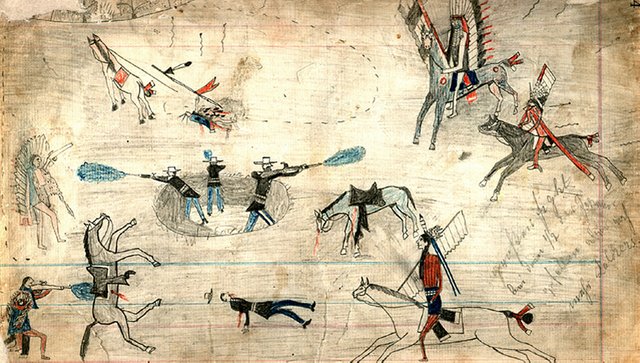


The picture above belongs to a class of narrative illustrations known as "Ledger Drawings". These were created by Native Americans who lived on the Plains of the United States in the late nineteenth and early twentieth centuries. Driven from ancestral homelands and onto reservations, the Native Americans recorded events on pieces of paper taken from ledger books of reservation managers. The illustrations augmented story telling, the vehicle which transmitted oral tradition from generation to generation. Ironically, many Ledger Drawings were created while the Native Americans were imprisoned at Fort Marion, in St. Augustine, Florida.
It is believed this picture (above) represents an 1874 battle that took place between the Kiowa and the United States Army, at Buffalo Wallow in the Red River War.

 Why do we appreciate art? Why do we create it? Does art have extrinsic value, besides the price it can fetch at auction?
Why do we appreciate art? Why do we create it? Does art have extrinsic value, besides the price it can fetch at auction?
 These are not easy questions, and each of us will likely have a different answer. One thing is certain, though: governments throughout history have recognized the power of art, and have sought to control artistic expression. This is so, because art speaks. Often, it speaks for those who have been denied a voice in the public forum.
These are not easy questions, and each of us will likely have a different answer. One thing is certain, though: governments throughout history have recognized the power of art, and have sought to control artistic expression. This is so, because art speaks. Often, it speaks for those who have been denied a voice in the public forum.
 Almost all the art shown on this page represents the experience of people under occupation by a foreign entity.
Almost all the art shown on this page represents the experience of people under occupation by a foreign entity.
 Art may speak with the force of a spear. This is evident in some of the pictures displayed here.
Art may speak with the force of a spear. This is evident in some of the pictures displayed here.

Ledger Art by Cheyenne Chief Howling Wolf

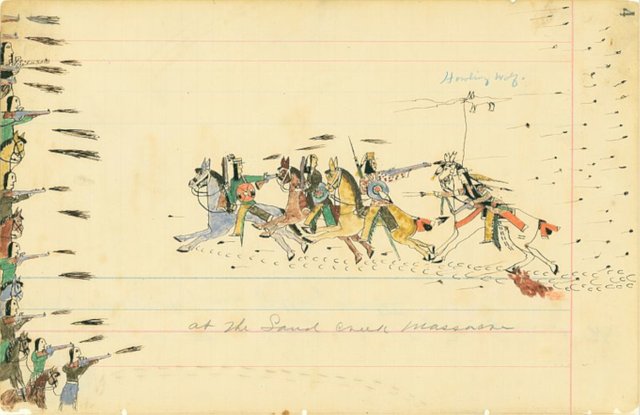

This drawing depicts a massacre of Native Americans that took place at Sand Creek, New Mexico in 1864. According to scholars at the Smithsonian, "Sand Creek was the My Lai of its day, a war crime exposed by soldiers and condemned by the U.S. government". The massacre was remarkable for its brutality, which included mutilations and the slaughter of women and children. It was also remarkable for the great number of witnesses left behind, who testified to what had occurred. One of the witnesses, Chief Howling Wolf, drew the picture displayed above.

 Sometimes art speaks obliquely. In certain cases, oblique messages have a more enduring influence than those delivered sharply.
Sometimes art speaks obliquely. In certain cases, oblique messages have a more enduring influence than those delivered sharply.
Ledger Drawing by Lakota Sioux Chief Black Hawk

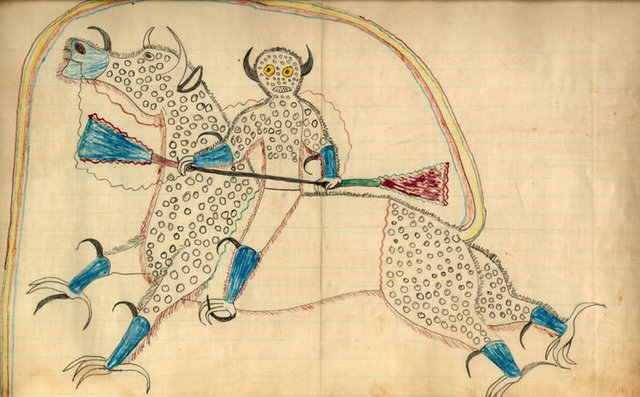%20public.jpg)

This picture features a heyókȟa, "one of the most powerful medicine people of the Lakota" tribe. The heyókȟa is an important figure in Lakota culture. He/she is part of the tribal mythology that connects the past to the present. Many of the remedies that have been traditionally favored by heyókȟa are used today.


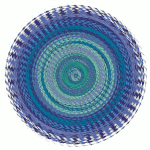


Peru
Pictures of graphic violence are in this section. If these will disturb you, please stop reading now.


Imprisonment of Tupac Amaru I
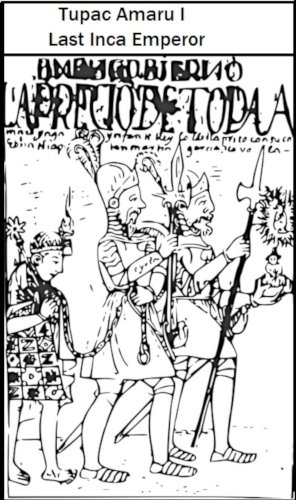

This illustration shows Tupac Amaru I, last Inca Emperor, as prisoner of Spanish soldiers. Before his capture, Tupac had led the remnants of the Inca Empire in rebellion against the Spanish. The picture here was drawn by Felipe Guamán Poma de Ayala (1535-1616) in his book, "Nueva Crónica y Buen Gobierno".

The Execution of Tupac Amaru I
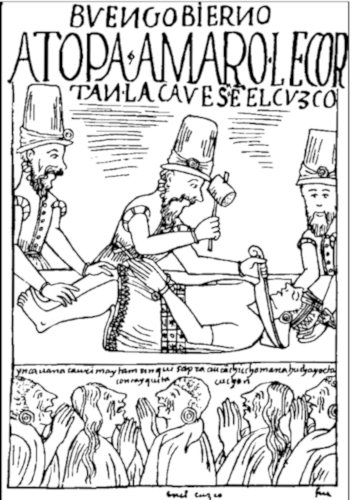

Tupac Amaru I had only been emperor for a short time when he was captured. During his imprisonment, he was subject to intense religious instruction and underwent conversion to Christianity. Once the conversion had taken place, he was decapitated. His head was placed on a spike. The head became an object of veneration (the Inca believed their emperors were immortal and worshiped their mummified remains.), and attracted great crowds.
The Spanish removed Tupac Amaru's head from the spike and buried it.

The Execution of Tupac Amaru II
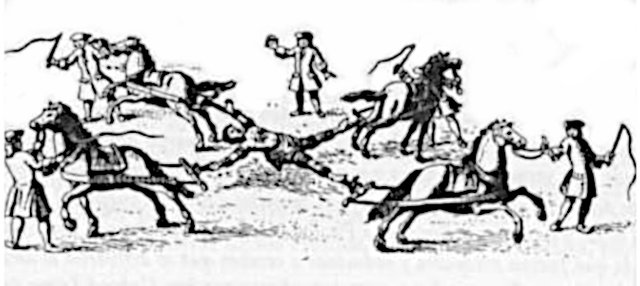

It is said that the man who called himself Tupac Amaru II was a descendant of Tupac Amaru I. As his namesake had done before him, Tupac Amaru II led a rebellion against the Spanish. And, as had transpired with his predecessor, Tupac Amaru II was captured and executed. However, his execution was even more brutal than had been that of his antecedent.
He was sentenced to have his tongue cut out. He was forced to watch the torture and murder of his family. He was also sentenced to have his body torn apart by four horses running in different directions, but this didn't work. So the Spanish untied him from the horses and decapitated him. After Tupac Amaru's death, his body was cut into pieces. These pieces were distributed to different parts of Peru.
The gruesome deaths of Tupac I and Tupac II were meant to dampen the spirit of rebellion, but had the opposite effect. For generations, even to the present, the name Tupac Amaru has been an inspiration for rebellion. The pictures drawn by Guamán Poma de Ayala helped to keep their stories alive.





Vietnam

Evacuation, by Tô Ngọc Vân (1908-1954)
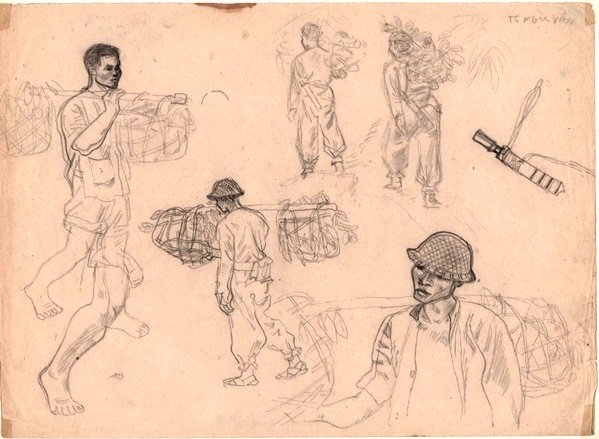

The author of this picture, Tô Ngọc Vân, (1908-1954) was said to have quoted Picasso: “War can be waged through painting.” This was perhaps a way of saying that art speaks powerfully.
Tô Ngọc Vân began his career as a painter under French colonial rule. His early work showed a strong European influence and consisted mostly of idealized landscapes and portraits. After the Viet Minh's August Revolution, Tô Ngọc Vân's work changed. He created posters, and pictures such as the one above, which carried strong political messages.





Australia

Aboriginal Hollow Log Tombs
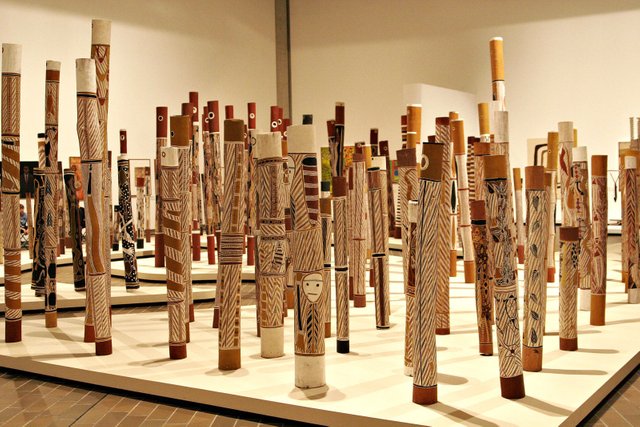
Image credit GFDL v1.2 license: Flagstaffotos
This installation of hollow log coffins is on display at the National Gallery of Australia, in Canberra. The artists who designed the coffins are members of clans whose traditional homes are in Central Arnhem Land, Australia. The Hollow Log Coffin installation represents "all the indigenous people who, since 1788, have lost their lives defending their land". The artists wanted their work to be displayed publicly, so future generations would remember, and honor, the struggles of their people.



Brazil

The Prophet Daniel, by Aleijadinho
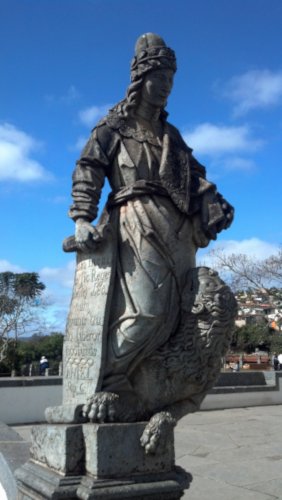
Photo credit: Pgaraujo. Used under CC 4.0 license.
The statue pictured above is one of twelve sculptures created by Antonio Francisco Lisboa at the Sanctuary of Bom Jesus of Matosinhos, in Brazil. Antonio Francisco Lisboa was more popularly known as Aleijadinho (the lame one) because, it is said, he had leprosy.
Aleijadinho's twelve towering statues depict the twelve apostles. While many critics believe these sculptures are posed as ballet dancers, one scholar, Monica Jayne Bowen, from Brigham University, sees more culturally relevant elements. She sees in the graceful poses an emulation of capoeira, a style of fighting with Afro-Brazilian origins. Ms. Bowen explains that the relative positions of the apostles and their gestures are typical of capoeira combatants. She asserts that the statues are "political propaganda" and " a call for liberation". While it was likely not safe for Aleijadinhoto to make such a statement openly, under Portuguese occupation, it would be relatively safe for him to send a subtle message through art.



India

Bharat Mata, by Abanindranath Tagore
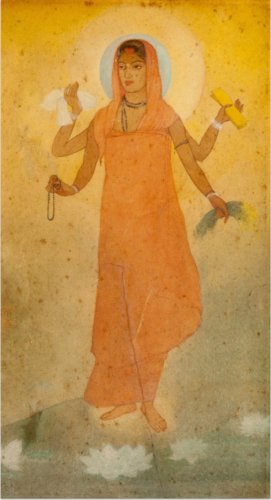

British colonial rule began in India with the Battle of Plassey in 1757. British domination of India lasted for almost two hundred years. Such a long period of colonial rule had a profound effect on Indian culture, and specifically on Indian art. In order to survive and prosper in this environment, many Indian artists (according to the Discover Society,) "... tried to adjust their painting styles to suit British preferences".
However, there always existed in India a nationalist sentiment, a desire for autonomy. By the end of the nineteenth century, this nationalist sentiment gained steam. Burgeoning nationalism was evident in the work of some artists, among them Abanindranath Tagore. His choice of subject in the painting featured above--Bharat Mata, (known as Mother India)--reflects that nationalist sentiment. Not only the choice of subject, but also Tagore's technique was seen as a "rejection of Western realism".





Democratic Republic of the Congo

Raffia Mat
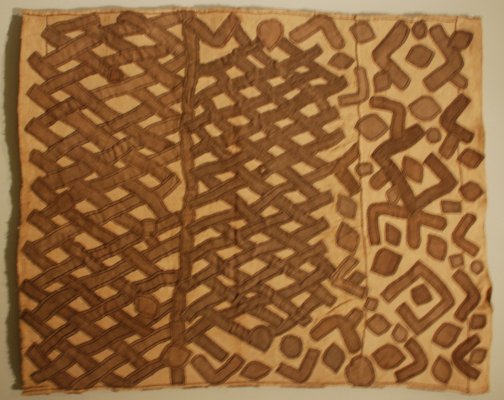
Image: Wikipedia Loves Art participant "Team_Yatta"; CC 2.5 license
The brutality of Belgian colonialism in the Congo was famously immortalized in Joseph Conrad's Heart of Darkness. In the midst of this oppressive regime, "There were artists living at that time...making their art...", according to UCLA scholar, Carlee Forbes.
One way artists responded to their environment was through the design of raffia mats. These mats had been in use since at least the fifteenth century. Textiles have traditionally been important in Congo as a form of currency. They were also displayed by local rulers as symbols of power. Over time, under colonial rule, the design of some raffia mats changed from being purely abstract, to including figures (such as panthers).





Poland

Sheeps in Fog, by Stanisław Witkiewicz
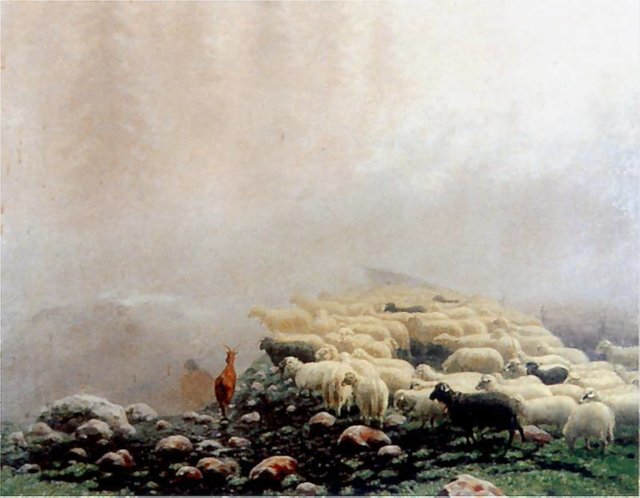

Poland shares borders with powerful neighbors. In the past, this has resulted in the nation's conquest and partition. However, despite these threats to its survival, Poland has always had a core of people who held onto the idea of the nation's identity. One of these was the artist Stanisław Witkiewicz. Witkiewicz advocated for using Polish nationalist themes and Polish naturalist landscape in art. He was drawn to mountain culture, as the scene in "Sheeps in Fog" exemplifies, above.





China

Fisherman, by Wu Zhen
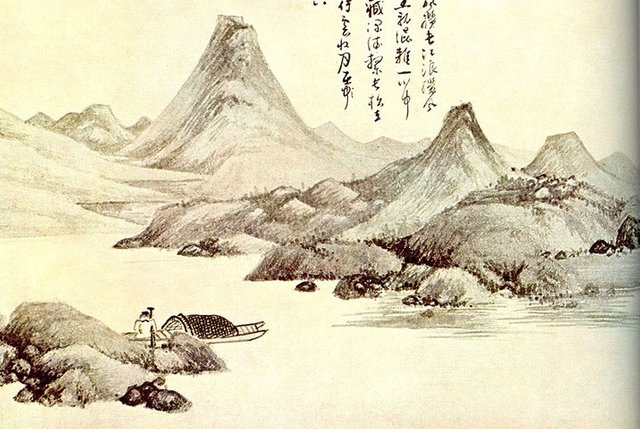

In 1279 AD, Kubla Khan swept across southern China and completed the Mongol conquest of the country. This was the beginning of the Yuan Dynasty, which would last until 1368. The Mongols left no room for dissent. Many elite indigenous Chinese reacted to Mongol oppression by retreating into the country and quietly pursuing scholarly endeavors that emphasized traditional Chinese values. This emphasis included a focus on Confucianism, Taoism and personal character. From this focus grew a body of art that has been characterized as literati art. This was not a new form of art, but it blossomed during the Yuan Dynasty.
At the end of Mongol rule, a legacy of literati art remained. This was, and still is, considered to be a treasure trove of Chinese culture and tradition. Wu Zhen, the artist whose picture is featured here, was one of the most esteemed of the Yuan Dynasty literati.




 Art selections from five continents and from different centuries are presented in this blog. No matter the origin, each piece speaks to us today. The language of art transcends the differences.
Art selections from five continents and from different centuries are presented in this blog. No matter the origin, each piece speaks to us today. The language of art transcends the differences.
I hope you enjoyed my whirlwind tour through art. Thank you for coming along on the journey.


Art Speaks
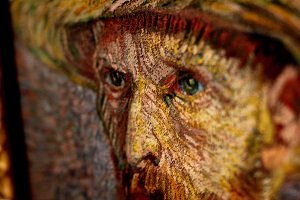



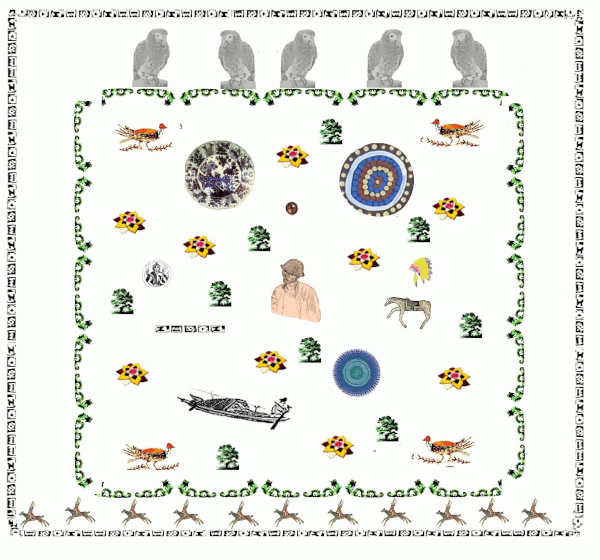



Public Domain Citations for Featured Art in the Blog (Not Otherwise Credited)
End picture by Vincent Van Gogh Pixabay
Accents/GIFs, All in the Public Domain(All Accents Used Have Cultural Significance for the Associated Culture)
- Horse:Horse extracted from Kiowa Ledger Drawing cited above
- Hopi excerpt.jpg:


 from Hopi Tile
from Hopi Tile - Spear Pixabay
- Headdress pixabay
- Blue disc adapted from Pixabay
- Inca border:design excerpted from design excerpted from Imprisonment of Tupac Amaru I
- Inca-Urco: Inca-Urco
- Supplicants extracted from Execution of Tupac Amaru illustration above
- Sun extracted from public domain image
- Dragon Pixabay
- Aboriginal art Pixabay
- Icon bird public domain
- India flower border Pixabay
- Congo Grey parrot Pixabay
- Bartek tree Public domain
- Chinese border peonie plate
- Pallet
Selected Research Sources:
Panhandle Plains: Education Lessons
Smithsonian Magazine: Horrific Sand Creek Masscre Will Be Forgotten No More
Society of Ethnobiology: Heyókȟa Medicine: Uses of Plant and Animals by the Clowns of the Lakota
Britannica: Biography Felipe Guaman Poma de Ayala
ThoughtCo: Biography of Tupac Amaru
Britannica: Biography of Tupac Amaru II
Vietnam The Art of War: Tô Ngọc Vân Biography
Peoples Dispatch: August Revolution in Vietnam Liberation of Hanoi
National Gallery of Australia: Aboriginal Memorial
Scholarship Archive Brigham University: Viewpoint
Britannica: Battle of Plassey
The Cultural Me: Abanindranath Tagore’s Bharat Mata and its Role in Fostering Indian Identity
Museums of India: Bharat Mata (Mother India)
The Conversation: How Conrad's Imperial Horror Story Heart of Darkness Resonates with Our Global Times
UNC Global: Art History Graduate Student Challenges Popular Narratives about Colonial Congo
Britannica: Partitions of Poland
China Highlights: Travel Guide the Yuan Dynasty
Culture Place: Artist Stanislaw Wtkiewicz
Smithsonian: National Museum of African Art
Africa Direct: Raffia Textiles//Kuba Textiles
Indiana University: Transmitting Sacred Knowledge: Aspects of Historical and Contemporary of Oglala Lakota Belief and Ritual
The Cultural Trip: North American Mexico Articles
The Localist: Muralism in Mexico
Texas State Historical Association: Buffalo Wallow Fight
Live Mint: The Origins of Bharat Mata
University of Agriculture in Krakow: Preliminary Results of the Monumental Tree Monitoring Based on Terrestrial Laser Scanning: A Case Study of the Oak Bartek in Zagnansk (Poland)
Discover Society.org: Visual Arts and Imperialism in India in the Eighteenth Century A Colonial Society in the Making
University of California, Irvine: "The Clown’s Way" by Barbara Tedlock
Austin Peay State University: Execution of Tupac Amaru I, Last Inca Emperor
Jamesqjacobs.net: Tupac Amaru, The Life, Times, and Execution of the Last Inca
Smithsonian: The Fascinating Afterlife of Peru’s Mummies
Telesur: The Killing of Tupac Amaru II: the Death Knell of Spanish Rule
Liberation School: Tupac Amaru II: Condor of Fire
China Online Museum: Literati Painting
You never cease to amaze me @agmoore! Art speaks volumes and the brutality and suffering that so many endured made me sick, but I am glad those involved were able to tell of their horrific lives. I don't know why but the one that was so powerful for me was the hollow log coffins. And here is the kicker...when I saw your collage of bringing the world together it gave me chills, inside and out. How profound! Your history lessons and your collages combined have come full circle and speaks volumes as well. Another standing ovation! Applause!
Thank you @whatisnew, for visiting my blog and appreciating my work. As I get older, art becomes more meaningful to me. For much of my life it was words, words, words. I think because I felt inept in art and words worked for me. But age is liberating, and my liberation finds expression in art, among other things.
I don't mean these to be lessons. Most of what I write I didn't know a few weeks ago. Sharing what I learn. I hope the excitement of my discoveries comes through and makes the blog more interesting.
You are always so generous in your appraisal of my efforts. That's the best part of blogging...the nice people I meet.
Have a wonderful day...it's Thursday!! Insect pub. I'll be there
Your friend,
AG
Oh, you definitely make the "lessons for me" very exciting. And I know exactly how you feel about wanting to share your excitement of what you have learned. I get that way about the insects I find and sharing them with friends here makes it so much more rewarding. I am looking forward to another one of your exciting learning adventures AG!
Have fun at the Insect Pub! LOL!
What an amazing, informative, and inspiring post. I love the Native American artwork at the start and marvel at how comprehensive this is, and at the same time, how much more there is that we would do well to be reminded of. The art of war, the war of art, the cultures that celebrate warriors - The Illiad, the Nibelungenlied, the Wagner operas. Literature like Dr. Zhivago. I especially love this: Poland (like Germany) with its long history of conquest and partition and loss of a national identity, retains it in part through art - "Poland has always had a core of people who held onto the idea of the nation's identity. One of these was the artist Stanisław Witkiewicz..." Well said. Thank you for this. And how did @curie or #oc overlook this one (or did they, and I overlooked the usual notice in the comment section)?
Thank you very much! Your comments are always a treat, full of information and references that add dimension to a post.
I haven't admitted it here (or anyplace at all, I think): When I graduated from high school I received a medal for interest in history. Ranging across continents and centuries comes naturally to me:) What's wonderful is, I can share that and other people are interested, also.
The thing about studying history is, you realize national kinships often outlive national boundaries. One is a matter of choice and the other is imposed.
What fun it was to write this. There really is a book in it, and I've started :))
(Waiting to upvote comments until my VP is over 95%--only way the vote doesn't turn to dust)
Regards,
AG
Oh that dust vote - some days I just vote anyway. One wasted cent. Can't we just have a "Like" button? A point system that doesn't involve wallets?
People who love history (and science) are the most interesting - in part because they are interested in other people and things bigger than themselves. The self-absorbed are much easier to find. -_- What an awesome high school, awarding you a medal for you interest in history! And I'm glad you find people who share your interests. I find people changing the subject or leaving the room when I trot out historical tidbits - e.g., the Meskwawi being the first Native Americans to legally own land in the U.S. Even the atom-smasher in CERN seems to be boring if I'm the one talking about it. (Not that I squat about physics!)
I love this: national kinships often outlive national boundaries
And I can't wait to see the book! There really is a book in it, and I've started :))
Fabulous. I feel a connection with all of these people, even centuries hence. That's what art does, bends time. Interesting topic to choose images from, war. People are at their best and worst in war, so here we have an exquisitely put together post, a work of art itself, depicting the human condition at its extremes. Very very good. My fave is the statue and the subtle call to arms of its pose. I love that. Thank you for putting this together.
Getting a tingle in the back of my neck as I read your comment.
Yes!
I love the statue also. And to think the man who sculpted it was profoundly disabled. The passion there!
Thank you so much for coming by, and touching my heart.
(I can't vote for your comment until tomorrow, or it will be dust)
Peace, and health, @owasco
AG
This is by far the best-written post I've read here on Steemit in the past week.I look forward to learn new things through your articles.
Breath on and keep creating !!
Lovely to meet you , Amore
You are wonderful to write that. I work quietly and doggedly. I love what I do. When a comment like yours comes through...that's really encouraging. After all, writers hope they will find an audience, even a small audience. Thank you for being my audience.
Lovely to meet you, also.
Health and Peace,
AG
I wrote this accidentally under my second account, agmoore2, which I use mostly for science blogs. I get confused sometimes between the two accounts. But it's all me :))
Some great observations ... surprising art examples that I see for the first time ... very interesting post. :) Very, very interesting.
Hi @borjan,
Thank you for visiting, and thank you for those nice comments. When I please an artist with my art tour...wow.
I was pretty familiar with Yuan Dynasty art when I started the blog, but everything else was new. Great fun learning, and looking at art from different cultures. I don't like barriers.:)
Looking forward to meeting more of your cats, by name. :))
:)
I wonder what artistic products our future curious people will discuss. Cyber art?
CC BY 2.5, https://en.wikipedia.org/w/index.php?curid=5400146
Will there then still be something like permanent art (in its physically tangible form)? Or is it pixels and bits, always over when no one is looking anymore? Similar to here, your blog and my blog and all blogs are their own art forum - a form of expression - that only lives as long as you click on it?
Contemporary performances basically, fleeting like a perfume. This can certainly be seen in many different ways ... The history of art is, as always, one with surprises, I think. It is also a contemporary one. What poetry tries to do with that which cannot be put into words, art tries through visualization.
Sorry, I'm in a bit of a morbid mood right now.
You have put together a good and very diverse collection here. It's nice that you have taken the continents and set an example from so many. At first sight I found the Raffia Matte irritating and amusing. It looked like a formerly symmetrical pattern dissolving into small males or animals.
Aesthetically, the Asians appeal to me the most. And then the Indian drawings. But ...the polish sheep: I so much love the painting.
The quadripartition: one can hardly believe it, can one?
Hello Erika,
Thank you for stopping by with that most interesting comment.
Art. For me, it is not separate from everything else. We speak of it that way, but as you can see by my blog, even the way text is presented is art. I agree, art is visual communication.
What will remain in the future? Just as in prehistoric times, only the most durable mediums will survive. Will they be holograms? Will they be inscribed on stone? Enclosed in time capsules? Sent to space on recordings?
Don't know. If anything remains of us, it will likely be an artifact, as the petroglyphs and cave paintings are today. Then those who happen upon these may puzzle about the nature of our culture.
As for my selections--these are limited by at least two factors: copyright restrictions and the fact that people in occupied areas are not free to express their native culture. So I had to find work that not only was created under occupation, but which also managed to somehow express the will of indigenous people.
Hope your mood lifts. Every now and then I get hit by one. I try to move around (my house gets clean) and distract myself until it goes away.
Wishing you brighter days, health, and peace.
Your friend, AG
Maybe we just made a circle and found ourselves in the arts we created ourselves in ancient times. I's you and me on that cave walls.
<3
Hello, as always delighting in your writings, learning a little more about art, how a single drawing can express a situation, speaking and telling a story by itself, there is a part that is cruel, of torture, but I still managed to read it . My greetings.
Thank you, friend, for reading and appreciating. Since I've started blogging on Steemit, I have gained more courage in my ability to express art. I do not have your talent, but I do have a love of art.
Hope you are well and peaceful.
AG
What a wonderful blog! Very very interesting stories and informations about cultures, art and the "hidden voices". The whole post is a piece of art itself! Every little detail chosen with love for a nice composition. And last bur not least the collage which integrates every part of your Blog to bring the world together! Great job dear Agmoore! Do you count the hours and days for your researches? Must be very many... Thank you for this amazing journey! Kadna und gaich
Hello @gaich and Kadna!
Two of my favorite people😂
You see everything I tried to do :)) Yes, hours and days. Even the parrots in the collage, if you look closely, are winking. Took a long time to get the wink down. And probably no one will see. But it pleases me :))
Thank you for your careful reading/viewing of the post. There is no practical explanation for putting together so much material so carefully, except that I love it.
You are right about the research. So much that I think this time there's actually enough for a small book, which is at this moment in the planning stage. Probably won't sell a single copy....but, still.
I appreciate your visit and support @gaich (and @Kadna). Votes on comments have to wait for a bit. Each one has to be at least an hour apart or they will turn to dust.
I'll be back :)))
With great affection and appreciation,
AG
Please don't worry about the votes - they are nice but not so important than a real comment ;-)
That is the best reason for doing something. Your blog is full of most worthy posts writen and composed with your heart! We (hehe) are glad to know you! Love KG
Thank you, friend. And thank @gaich for me too 😇
😂😂
You just received DERANGED @agmoore Keep up the great work. Congrats, you have been gifted 1 DerangedCoin. You can redeem 20 of them for an upvote from the deranged.coin account. Redeem your tokens by sending to deranged.coin through Steem Engine with your post URL in the memo field, view all your tokens at steem-engine.com
Thank you!!